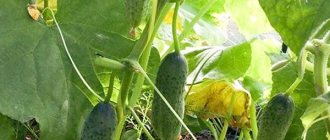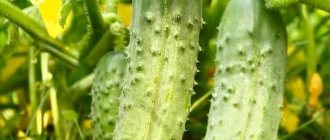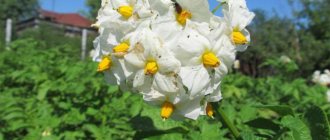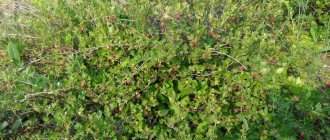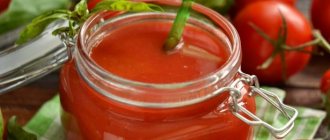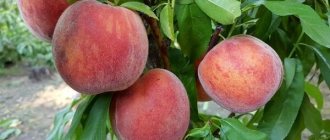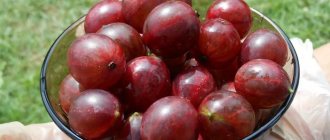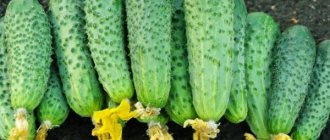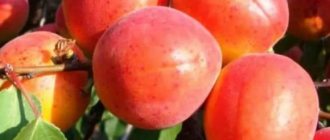Vegetable growing » Cucumbers
0
1673
Article rating
Kira Stoletova
The Harmonist cucumber variety is a novelty in the modern vegetable market. It is characterized by high yield and taste, so every gardener wants to grow this variety on his own plot. Moreover, it does not require special care, which is great for beginners in the field of gardening.
Description of the cucumber variety Harmonist
Cucumbers “in a shirt”
This term refers to the nature of the surface of the fruit. Today there are a number of varieties of hybrids, each of which is good in its own direction. For example, the “Russian shirt” is characterized by large, sparse tubercles. They are great for pickling. “Dutch shirt” are medium-sized tubercles, located quite sparsely. And relatively recently, we have hybrids with a “German shirt”. These are small fruits with very small and frequent tubercles. It has one more feature - it is “fluffy”. The spines are located not only on the tubercles, but also on the entire surface of the fruit. This is exactly what the Harmonist F1 cucumber is. Reviews from gardeners emphasize that it is good both fresh and lightly salted, since the brine penetrates evenly and quickly into the fruit, which ensures the highest taste.
general description
If the spring sun is shining outside, then it’s time to start preparing the soil for planting. Now is the hottest time, because the future harvest depends on how early the F1 cucumbers hit the soil. Reviews note that this early-ripening variety pleases with an abundance of fruits even if you are a little late, but it best demonstrates its qualities when planted on time.
Therefore, we don’t delay and sow cucumbers in cups in early spring. It is best to use peat for this. Cucumbers do not tolerate transplantation very well, but in this case they will not get sick and will quickly begin to grow.
Harvesting
Harmonist cucumbers ripen within 40–45 days after emergence, since the variety is early ripening. Harvesting must be done in a timely manner, which will give the bush the strength to produce a high-quality harvest. If cucumbers are picked when they are overgrown, the number of ovaries may decrease.
Cucumbers of this variety are universal and suitable for:
- canning;
- pickling;
- fresh use for salads.
Cucumbers of the hybrid variety Harmonist do not require special growing and care conditions, they are not susceptible to many diseases characteristic of this crop. Even novice farmers can grow them; the variety has high yields.
For greenhouses and garden beds
Under what conditions do Harmonist F1 cucumbers perform best? Reviews repeatedly confirm that this variety will grow equally well in an open garden bed and in a greenhouse. This is an early ripening hybrid that ripens in about 40 days, and does well without pollination, which means it will grow in a closed greenhouse. But most of all, summer residents love this variety for the quality of its fruits.
Cylindrical, dark green cucumbers weigh about 100 grams each. The length of the fruit is relatively small - 10-13 cm. Ideal size for fresh use and preparations. At the same time, many people leave varieties for pickling that will begin to bear fruit a little later. For now, you need to enjoy the first salads and lightly salted fruits. And in this, the real champion is the Harmonist F1 cucumber. Reviews from summer residents emphasize its high productivity. From one square meter you can collect approximately 12-15 kg. If you decide to plant this variety as an early salad variety, you won’t need too many bushes to satisfy your family’s need for greens.
Advantages and disadvantages of hybrid culture
The main benefits of the Harmonist cucumber include:
- resistance to common infectious diseases;
- precocity;
- long fruiting period;
- abundance of harvest;
- high taste qualities;
- lack of bitter taste;
- long-term storage and suitability for long-distance transportation;
- undemanding in care.
Disadvantages of a hybrid:
- loves moisture, but its excess causes the roots to rot;
- when grown in open ground, fruits are often deformed;
- there is a risk of a decrease in the number of cucumber ovaries due to overgrowth;
- inability to use fruit seeds as planting material.
Preparing seedlings
Cucumbers are very heat-loving plants, and since spring in Russia can be long, it is not recommended to plant directly into the ground without additional insulation. This can be a greenhouse or greenhouse; some people make a high bed, the lower layers of which are filled with manure. From early spring, a film is stretched over it and you get an excellent shelter for cucumbers without additional heating costs. But summer residents still prefer not to procrastinate and prepare the seedlings in advance, on the windowsill. In what conditions does the Harmonist F1 cucumber grow best? Reviews suggest that this variety is quite loyal and will easily tolerate even some of the mistakes of a novice gardener.
How to sow seeds in open ground correctly
Cucumbers of this hybrid species can be grown both in open ground and under greenhouse protection. In many ways, the method of growing this variety depends on the region and weather conditions, however, regardless of the planting method, the Harmonista bush has a high yield.
Deadlines
Harmonist cucumber seeds are sowed in open ground when the soil has already warmed up well and its temperature is at least 25°C. As a rule, on average, seed planting occurs at the end of May - beginning of June. However, many people prefer to plant using seedlings.
This option is especially suitable in those regions where the soil does not receive enough sunlight and is poorly heated due to a long and cold spring.
Then the seeds for seedlings are planted in peat cups in April-May, and already in June, approximately 25 days after sowing, when several leaves appear, the seedlings are transferred to open beds.
To insulate them, you can use a film that is stretched over the beds, creating a kind of greenhouse and protecting them from sunlight, or you can organize a so-called “warm” bed: the bottom layer of the bed is filled with manure, raising its natural level.
Germination of seeds
The peculiarity of the hybrid is that you don’t have to waste time on additional soaking. Its germination rate is almost 100%, so just prepare the soil for planting day. For this purpose, it is better to use a universal one intended for vegetables. If you make the soil mixture yourself, be sure to use peat and sand to create a light and nutritious soil.
For individual planting, you can use pots with retractable bottoms, peat cups or tablets. The main thing is to injure the roots as little as possible when planting. This is what the Harmonist F1 cucumber fears most. Reviews (we provide photos and descriptions of the variety in our article specifically to familiarize yourself with the culture) say that this hybrid is so tenacious that it can easily tolerate even an ordinary pick from a common box.
How to plant
So, the prepared containers need to be filled with soil mixture about 2/3 and watered well with warm water. Do not forget to leave it well and warm it: cucumber is sensitive to chlorine impurities, and the roots are very sensitive to cold. Now we deepen the seeds into the soil and cover the pots with film or glass. As a rule, seedlings can be expected within 3-5 days. If one of the pots is “late,” then it’s worth checking whether there is a sprout in the soil. As it grows, you need to add soil to the container and do not forget to water it. A sufficient amount of moisture is the key to success in growing this plant, as reviews say about Harmonist F1 cucumbers. We will provide a photo of a bush that was grown according to all the rules in the article so that you have something to compare your plantings with.
Landing
It is recommended to plant this hybrid in seedlings in cold regions and without seedlings in warm regions. In the north of the Russian Federation and in similar climatic zones, it is preferable to grow through seedlings in a greenhouse, since in cold soil the roots can rot and the plants die.
Seeds from Gavrish do not require preparation before planting. Seedlings are sown at the beginning of April to grow cucumbers in a greenhouse, or at the end for open ground. A nutrient substrate is prepared for it from soil, peat, humus and drainage - sand, sawdust or vermiculite. It is recommended to use peat pots, which help protect the fragile roots of the bushes.
1-2 seeds are sown in each container, moistened, covered with film and kept until germination at a temperature of +20-25 degrees. Then it is reduced to +16-19 at night and +20-21 during the day, and the pots are placed on a sunlit windowsill. You can feed it once with mineral fertilizer. After 30 days, the seedlings are transferred to the garden bed.
Seeds are sown in open ground in late May - early June. In the spring, the bed must be dug up and for each square meter, add a bucket of humus or compost and 15 g of mineral fertilizers - superphosphate, potassium nitrate.
The holes are made according to the pattern 40 by 40 cm, maybe a little more. Depth - no more than 2-3 cm. After planting the seeds, the soil is moistened, mulched with peat, and covered with film on top. It is removed when sprouts appear.
Cucumber Harmonist F1: description, reviews, photos
Planting and care is a series of relatively simple procedures that must be performed on time and one after another, and then success is guaranteed. The soil in the garden must be fertilized with compost, ash and manure. Before removing the seedlings, prepare the holes at a distance of 50 cm from each other. Give them a good soaking with water. Now you can proceed to the actual landing. All that remains is to sprinkle the young shoots with soil, cover them with film and shade them a little from the hot sun. After a couple of days (if the weather is warm enough), the covering material can be removed.
Disease Prevention
This variety is quite resistant to common diseases
But it is important to understand that preventive measures will never be superfluous, because the future harvest depends on it. As a preventive measure, it is necessary to use preparations containing copper
They will prevent the emergence of diseases from which this species is not yet protected.
For the sake of experiment, I planted cucumbers of the Harmonist variety. Not bad cucumbers. There is nothing outstanding about them: they are ordinary, but for universal purposes, and such are needed. Conventional agricultural technology was used for this variety. The higher the bed, the better. I prepare it in advance. At the very bottom go mowed lawn grass, dandelions, then compost with fertilizers, sawdust, ash, and finally earth. I plant all cucumbers only in seedlings, although just in case of emergency I plant one seed every 30-40 cm. Watering is important for this variety; I water it as the soil dries out, and when I have just planted the seedlings - every day. The liana grows well in my garden bed, occasionally, once every 2 weeks I additionally water it, first with a solution of nitrogen fertilizer, then with phosphorus-potassium fertilizer. I tie the grown vine to a trellis and pinch it at a height of 1.5 meters. Cucumbers grow in bunches of 2-3 pieces, 10 cm in size, you can collect fewer or more. There is no particular difference in taste: the small ones are more tender. They are without bitterness and crispy. The first cucumber was eaten after 47 days, which is not bad for the Sverdlovsk region.
We grow the “Harmonist” variety both for ourselves and for sale. I usually buy seeds from a trusted store in Voronezh, germination is stable, no surprises. I don’t do any preparation—I immediately plant the seeds in the greenhouse. We usually fertilize the soil in late autumn; for this we use any organic matter - compost or mullein solution. We prepare furrows up to 5-7 cm deep and place 2 seeds in them at a distance of 50 cm. Abundant watering is required; it is also preferable not to open the greenhouse until the trellis is tied, ensuring a constant temperature. We have trellises up to 2 meters high, we help the sprouts to gain a foothold on them. We pinch the side shoots - this way there are more ovaries on the bushes, and the cucumbers ripen faster. We apply phosphorus-potassium fertilizers once a season. We carry out the first harvest of cucumbers of this variety after 35-40 days. Cucumbers are smooth, up to 12 cm long. The skin is thin and does not taste bitter. Regular watering is needed, especially when the greenhouse is opened. During the season, we collect a bucket of cucumbers from each planted bush. They are in stable demand on the market because they have a beautiful presentation and small seeds inside. I also use this variety for pickling - it’s tasty and beautiful in appearance.
“Harmonist” grows better in nutritious soil. We grow it in a greenhouse or under arches in sprouts with 4-5 leaves. We plant in mid or early May. Medium early variety. We get our first cucumber in 45-50 days and in a greenhouse. Loves the sun and watering! It’s good that the vine is compact and does not cover the space in the greenhouse with its foliage. Its length is approximately 1.5 meters, there are few lashes. Cucumbers grow in bunches, all almost the same size - convenient for pickling. The taste is good: aromatic, not bitter, sweet and juicy, thin skin.
- 5
- 4
- 3
- 2
- 1
(0 votes, average: 0 out of 5)
Summer care
Relative unpretentiousness is the main feature for which summer residents love the Harmonist F1 cucumber. Descriptions, reviews - everything suggests that even without any experience in gardening, you will definitely get excellent results. And now we will share with you the main secrets of success, which allow you to increase fruiting from each bush, which means you can reduce the planted area with the same result.
- Before flowering begins, when the first buds appear, it is very useful to feed the plants with a solution of bird droppings. Do not forget that exceeding the dosage is unacceptable here, so make the solution in a ratio of 1:20.
- The first cucumbers are starting to form - it’s time to add mullein solution.
- The period of mass harvesting is coming. The plant is now devoting all its energy to growing greens and is more susceptible to diseases than ever. Therefore, throughout the entire fruiting period, use infused bread crusts and onion peels for watering.
- Effective protection against pests will be the use of ash infusion. Cucumber Harmonist F1 is quite resistant to powdery mildew and other diseases, but 3-4 times during the fruiting period such a preventive measure will not hurt.
- Watering is the most important thing in the life of a cucumber. If it is not too hot outside, you can do it 1-2 times a week. Do not pour over the lashes - this can cause burns to the leaves. Water is supplied strictly to the root, carefully so as not to wash out the roots. If the air temperature is very high - 30 degrees or more - you can water more often.
- Regular harvesting of fruits is very important, because while on the branch, the greens continue to draw strength from the plant.
Agrotechnics of cultivation and care
To grow the Artist cucumber on his personal yard, they use seed and seedling methods.
If the decision is made to grow seedlings first, then the Artist cucumber seeds begin to be sown in the first ten days of April. Typically, material purchased directly from the manufacturer is fully prepared for sowing, which is reflected in the instructions. If there is no information, then you need to carry out several preparatory measures yourself:
- They sort through the seeds, removing damaged specimens.
- Fill with warm water and discard all seed material that floats to the top.
- The remaining full-bodied seeds are disinfected, a light pink solution of potassium permanganate is prepared and the planting material is kept in it for 15 minutes.
- Prepare the soil substrate by combining sawdust, humus and peat in a ratio of 1:2:2. Heat at 180°C for 20 minutes in the oven. For each bucket of cooled mixture, add 40 g of ash and 30 g of nitrophoska. Or you can purchase a ready-made soil mixture.
Since Artist F1 cucumbers do not tolerate picking well, you should immediately prepare individual containers that are filled with prepared soil. After moistening, two seeds are sown in shallow holes. Cover them with a layer of earth no more than 2 cm.
Cover the container with film and place it in a bright place where the temperature is maintained at 22-27°C. The miniature greenhouse is ventilated daily and, if necessary, the soil is irrigated with water. After emergence of seedlings, the shelter is removed. The temperature is reduced to 20-22°C. Care consists of timely watering without moisture getting on the leaf plates.
Of the two shoots, one most powerful specimen is left in each separate container
The second is carefully cut with scissors, without pulling it out, so as not to damage the root system.
When the first leaves form, the seedlings need to be treated with mineral fertilizers according to the manufacturer's instructions.
In spring, when daylight hours are short, seedlings are provided with additional lighting. After about a month, when the fourth leaf develops, the seedlings can be moved to a permanent place in a greenhouse, greenhouse or open bed. Make row spacings of 0.6 m, leaving a distance between plants of about 0.4 m.
When growing in open ground, select a sunny area, protected from drafts. It is not recommended to plant cucumbers in one place every year. Legumes, dill, corn, beets, lettuce can grow nearby, that is, crops that have a beneficial effect on the development of cucumbers. Proximity to radishes, tomatoes, and radishes is not recommended.
If you practice direct sowing of prepared seed directly into the ground, then you should first prepare the soil. The site is dug up, weeds are removed, and rotted compost or manure is added. Acidic soil requires adding half a glass of ash per m2.
High ridges are formed, the average width of which is 100 cm. Sowing is carried out when the soil has already warmed up well to a temperature of at least 15°C, and for the air this indicator is set at 22°C.
The prepared bed is leveled and small holes up to 2 cm deep are marked, maintaining a distance of 15 cm between them. Two seeds are placed in each hole.
When two leaves develop, excess seedlings are removed, leaving strong plants with a gap of 15 cm.
Since the Artist F1 hybrid is characterized by uncontrolled growth, in open ground the main stem is pinched above the sixth leaf, which promotes the development of lateral shoots. They are pinched after reaching a length of 0.5 m. Be sure to install a support. In greenhouses, cucumber bushes are formed into one stem, which is tied to a trellis.
Basic care for cucumbers includes regular watering in the evening or early morning, without allowing the soil to dry out too much. If there is a lack of moisture in the fruits, bitterness may appear. Use warm water, which must first settle.
Organic matter and minerals are used for feeding. The first application of nutrients is practiced at the stage of active foliage formation. Then you need to make four more feedings, alternating organic matter (mullein, bird infusion, ash) and a mineral complex.
Despite the pronounced resistance to many diseases, for the Artist F1 cucumber it is necessary to carry out preventive spraying before flowering with Topaz. If slugs are noticed under the leaves on the soil, they pollinate the plantings with tobacco dust. Wood ash also helps.
For aphids, an infusion is prepared from hot red pepper - 10 g and tobacco dust - 200 g. This amount is diluted in 10 liters of water heated to 60°C. The above-ground part is irrigated with the strained infusion. Colloidal sulfur is used against spider mites.
Reviews from summer residents
Today, the Harmonist F1 cucumber is already known and loved by many summer residents. Description, reviews, photos - all this information is important when you first meet it. Next year you will already be looking for this variety in the store, like an old friend. Most gardeners really like the taste and high yield levels. The cucumbers are even, beautiful, all one to one. A 2-meter piece of land and 7-10 seeds will provide you with fresh fruits, and even enough for canning.
In addition, summer residents are pleased to note that cucumbers calmly tolerate pest invasion. Not all varieties can boast of this. And you don’t even have to further process the bushes. At the same time, the yield is excellent, the main thing is to remember to collect the fruits on time.
History and characteristics
The recently developed variety deserves everyone's attention, first of all, due to its taste and the ability to grow cucumbers in almost any region and climatic conditions of the country.
Selection
In 2008, the state register of the Russian Federation in 7 regions was replenished with another variety of cucumbers - Harmonist F1. It was bred through the efforts of breeders and recommended for cultivation in all regions of this country, with the exception of the Ural, East Siberian, West Siberian, and Lower Volga regions.
The authors are:
- S. F. Gavrish;
- A. V. Shamshina;
- A. E. Portyankin;
- V. N. Shevkunov.
Description of the variety
Harmonist is an early ripening variety that can be grown:
- in open ground;
- under the film;
- in glass greenhouses.
The first fruits appear on the bushes 40–42 days after emergence. Harmonist is a parthenocarpic species with a female flowering pattern, which means that it is self-pollinating and does not require insect intervention.
The bush of this variety is medium-sized, with branching below the average level. The bushes grow on average 1–2 m tall. The leaves are colored green with shades from green to darker, more saturated. They are medium in size. There are 3–4 ovaries in one leaf axil.
The shape of cucumbers is cylindrical with small tubercles. The average fruit weight is 100–120 g. Each cucumber is 10–13 cm in length and 3–3.5 cm in diameter. The peel is dark green, with a lighter shade towards the tips. Pubescence may often be observed.
Small specks or stripes of a lighter tone and small size are allowed.
The cucumber pulp is crunchy and has no bitterness and has a dense consistency. Small cucumber seeds. The yield of the Harmonist variety is 12–13 kg/m².
This hybrid is universal and can be used both for preparing fresh salads in season and for pickling and canning.
Advantages and disadvantages
- The advantages of this variety include the following characteristics:
- self-pollinating;
- precocious;
- long and high productivity;
- taste without bitterness;
- dense and crispy pulp structure;
- universal application;
- resistant to a number of common cucumber diseases, including: cladosporiosis, powdery mildew, root rot, downy mildew;
- good presentation even after long transportation.
The disadvantage of Harmonist F1 is the inability to use seeds from collected cucumbers for planting a subsequent crop. You need to purchase seeds every year.

